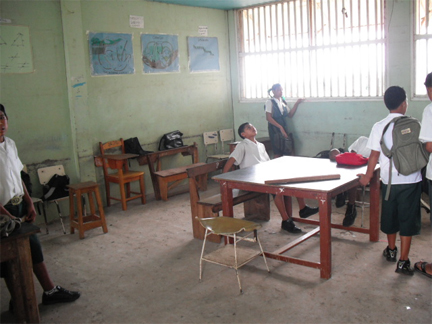Students of the top secondary in Region 9 face many difficulties on their way to and from school.
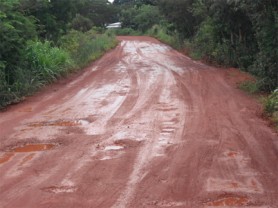
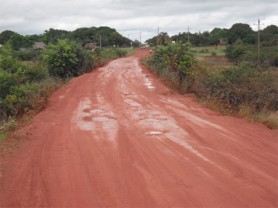
The school is located in the Amerindian Village of St. Ignatius (Upper Takutu/Upper Essequibo) and has an enrollment of 577 students. These students are the cream from the National Grade Six Assessment and come from all corners of this vast region. As a consequence, there is a live-in arrangement for students and teachers who hail from the far-flung areas. There are dormitories for both male and female students and housing facilities for teachers, some of whom are from coastal Guyana. All of these facilities are located in the large compound of the school and are overseen by the Headmistress.
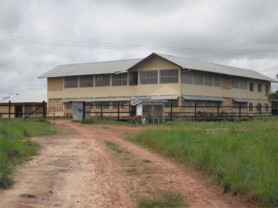
SN was informed of some of the difficulties and took the four-mile trek that some students take twice daily. The journey began at Tabatinga new housing area just after persistent rains that began the night before and stopped just at around 7:45 am. Once at the school, which was on mid-morning break, some students recognised this reporter and clamoured to make comments. When told of the journey, most of them had a knowing look. One brave girl blurted out “sir, we does have to do that twice every day, but it is much more difficult in the dry season.”
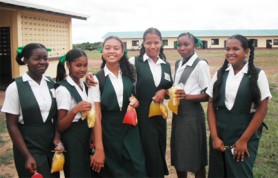
The journey took this reporter through tracks that could be deemed mini creeks of loam-red water. This was evident since most of the students’ white socks were badly discoloured. The main roads were pockmarked with potholes. Some of these roads were covered with a thin layer of asphalt last September and the poor conceptualization of the project was exposed by this year’s rainy season.
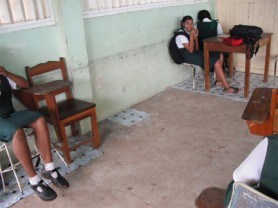
Most motorists sped along the watery roads drenching road users who were on foot or bicycles. Some did slow down though, when these road users approached. Then there was the slippery strip that wound its way through the high water of the watershed area of the Moco Moco Creek. From the top of the dam to the depths of the water below is around eight feet. A vehicle slipping off the strip, or a child being forced off the road by some unthinking motorist to the water below would be a tragedy.
Seventeen subjects
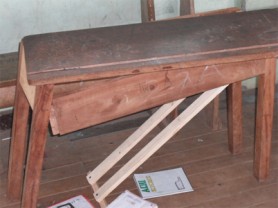
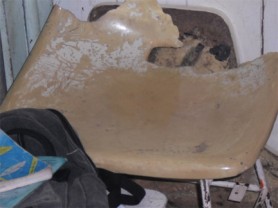
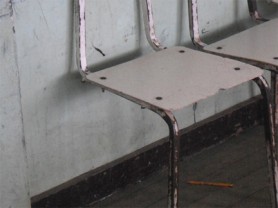
While in the Headmistress’s office, a very comfortable, but busy cubicle, this reporter was briefed on some of the successes and challenges of the school. The Headmistress informed SN that the school now offers tutoring in 17 subject areas namely: Math, English A, English B, Social Studies, Integrated Science, Agriculture Science, Food and Nutrition, Technical Drawing, Principles of Business, Principles of Accounts, Office Administra-tion, Chemistry, Biology, Physics, Information Techno-logy, Geography and Visual Arts. She said that this was not the case a few years ago when only eight subject areas were offered.
The Headmistress decried the state and quality of furniture available at the school. The classrooms that SN visited seemed like storage rooms for damaged furniture. Some of the benches and chairs had seen better days and were fit for firewood, but the children were making the best of them.
The desks and tables fared no better. Some classrooms were sparsely furnished. In one such classroom, students placed linoleum on the floor to sit on. The Headmistress said that several appeals were made to the authorities, but even when furniture is supplied, the pieces are not of good quality.
On the way back to Lethem, and at the behest of some of the students, SN took a walk through what the students call the shortcut. This route is used in the dry season and takes about a mile off of the journey. The shortcut on this day was waterlogged and interspersed with ditches.
The track was heavily overgrown with bush that the female students say is “a regular thing.” One student told SN “We are afraid most of the times.”
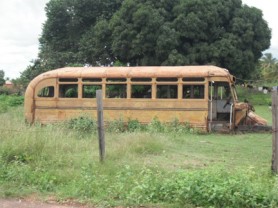
SN learnt that in the 70’s and 80’s the regional authorities used to provide transportation for students of the school because of the very same fears that students are now expressing.
At first a makeshift truck was used, then the Canadian Authorities donated a yellow bus, the kind that used to ply the Georgetown area from the Stabroek Market area during the 60’s, 70’s and 80’s. The bus was air-lifted to Lethem with 100 drums of fuel. SN caught up with the driver of the bus, Denton Usher to get a first-hand account of the service.
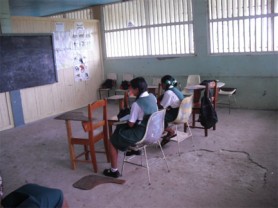
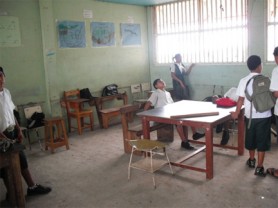
Usher said that the service started early in the mornings when he had to take the older children to school first. The next trip was into Moco Moco and Kumu to take children from those areas to school.
On his return to the school he would then return to Lethem once again to take the younger children. He said the system worked well until the bus went down for repairs in 1987 and never worked again.
He was of the view that things have changed dramatically since then, and the need for that kind of service is more needed now than then.
Parents are also of the same view. One mother said that she will feel more assured knowing that her daughter is going to school on a big bus with a responsible driver, than walking the potentially dangerous journey to school. She said that “nothing happens, nothing said, but it is only time.” Another parent said that he works in Bartica and he knows that children from across the river are assisted with transportation to go to school in Bartica.
When SN contacted the regional authorities in Linden it was confirmed that Falmouth is in Region 10, but residents look to Bartica for their survival. He said that there is an arrangement between the RDCs of 10 and 7, where Region 10 supplies a warrant on a monthly basis to purchase fuel that is used to assist students living at Falmouth to travel by boat to attend school in Bartica.
Residents in Lethem are calling on the relevant authorities to institute a similar scheme here to ensure that their children get to school safely.
This, they say, will put them more at ease and some of the stress will be lifted. It must be noted that children still travel from Moco Moco and Kumu to the school in St. Ignatius, this time though, by bicycle.
SN attempted to get a comment from the Education Department at Lethem and was told that the Regional Education Officer was on leave and the officer acting in that capacity was in the fields.
The most senior officer in office, the District Education Officer, declined comment saying that she was not authorised to speak with the press.
